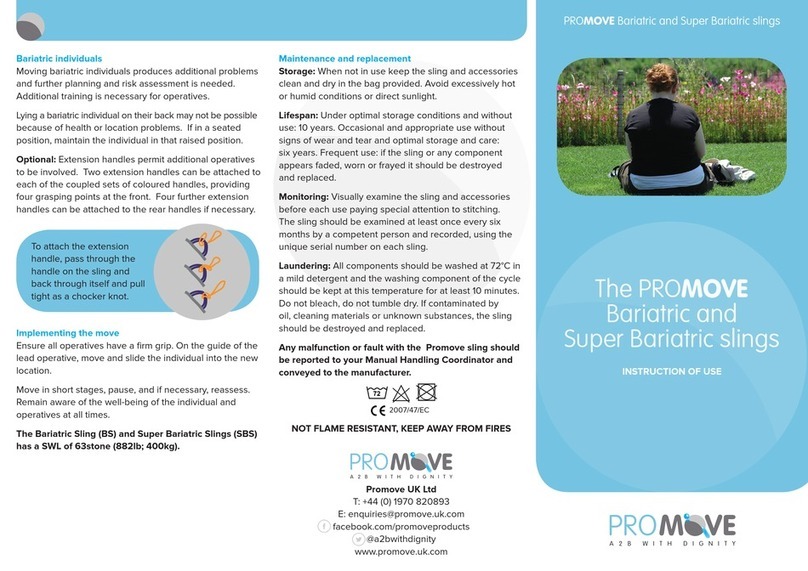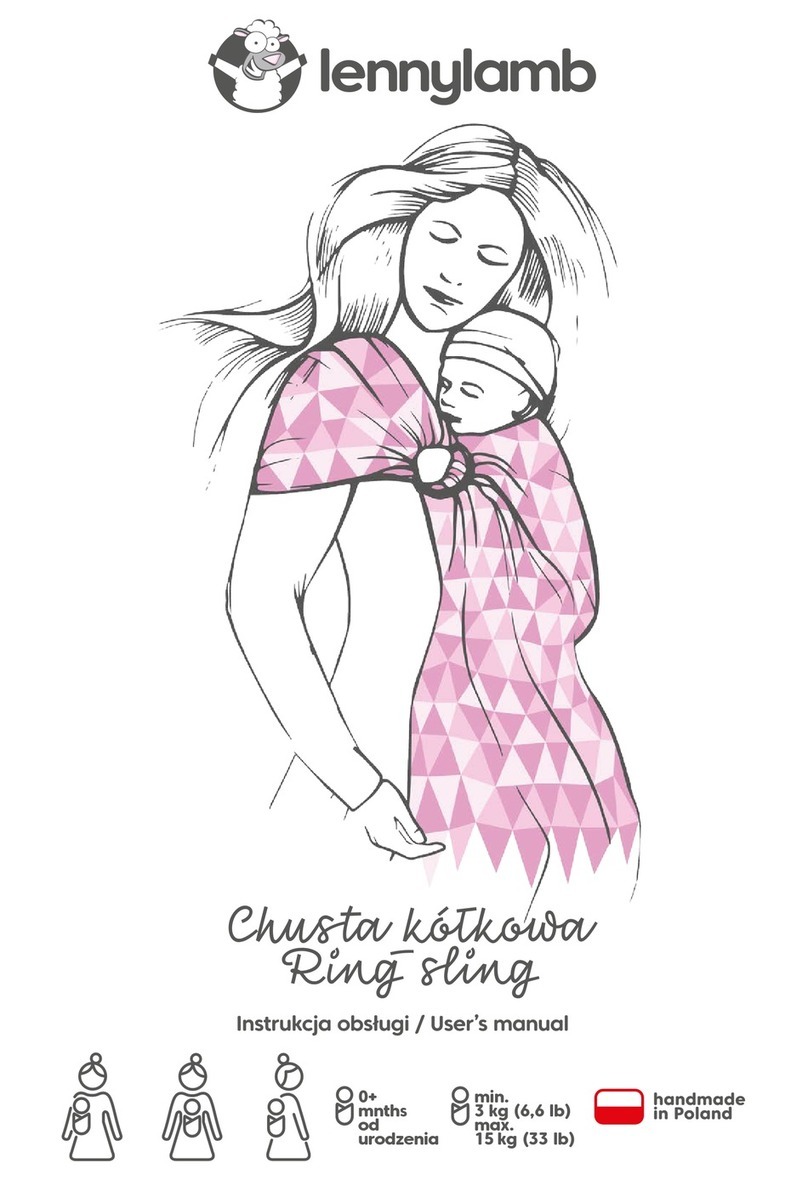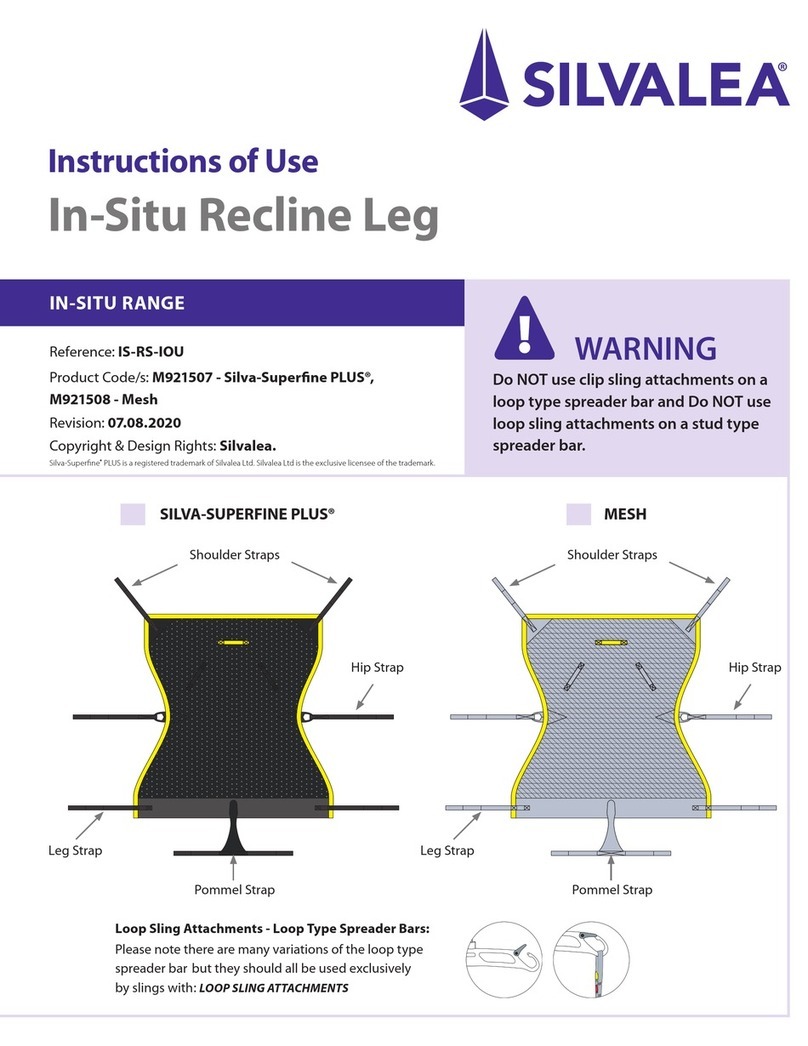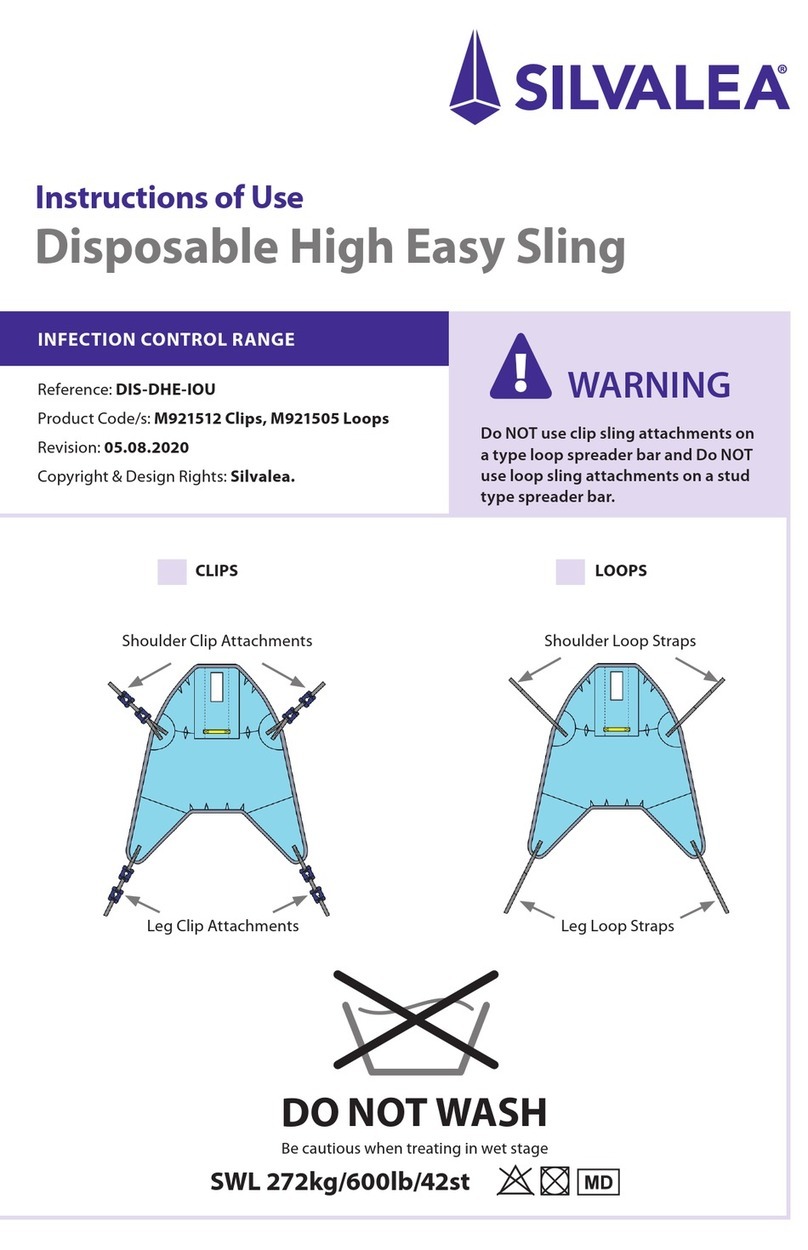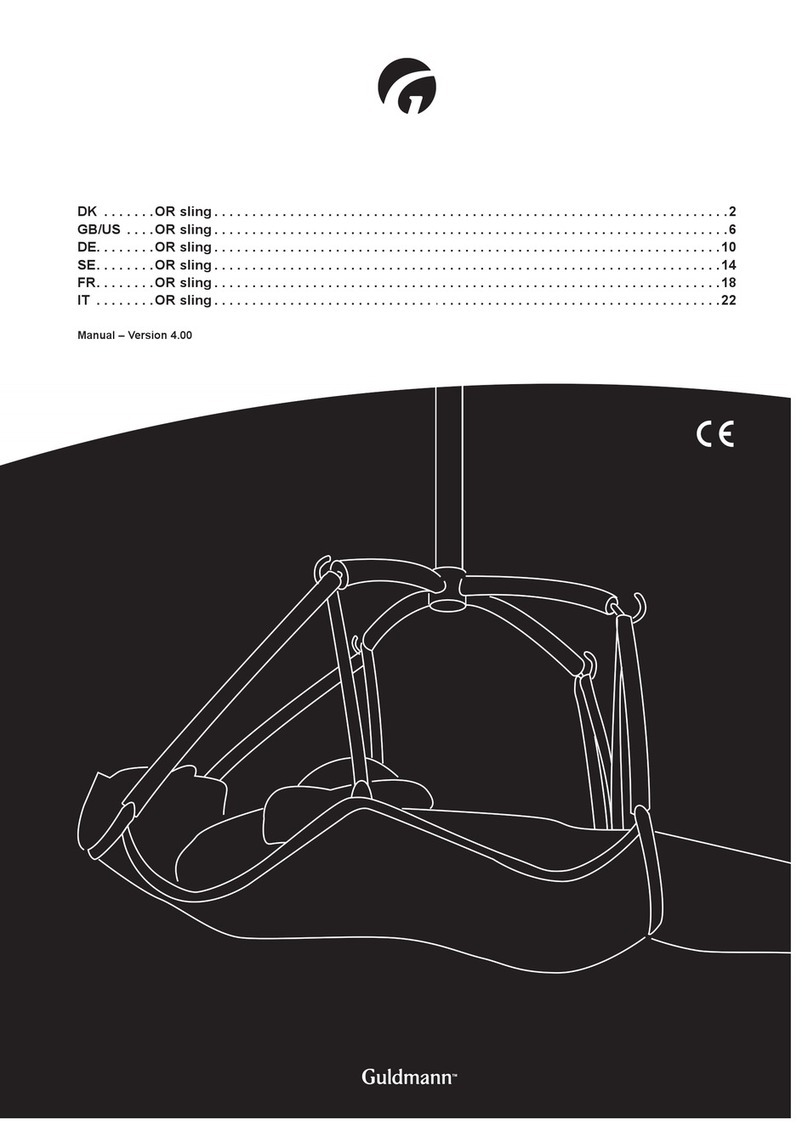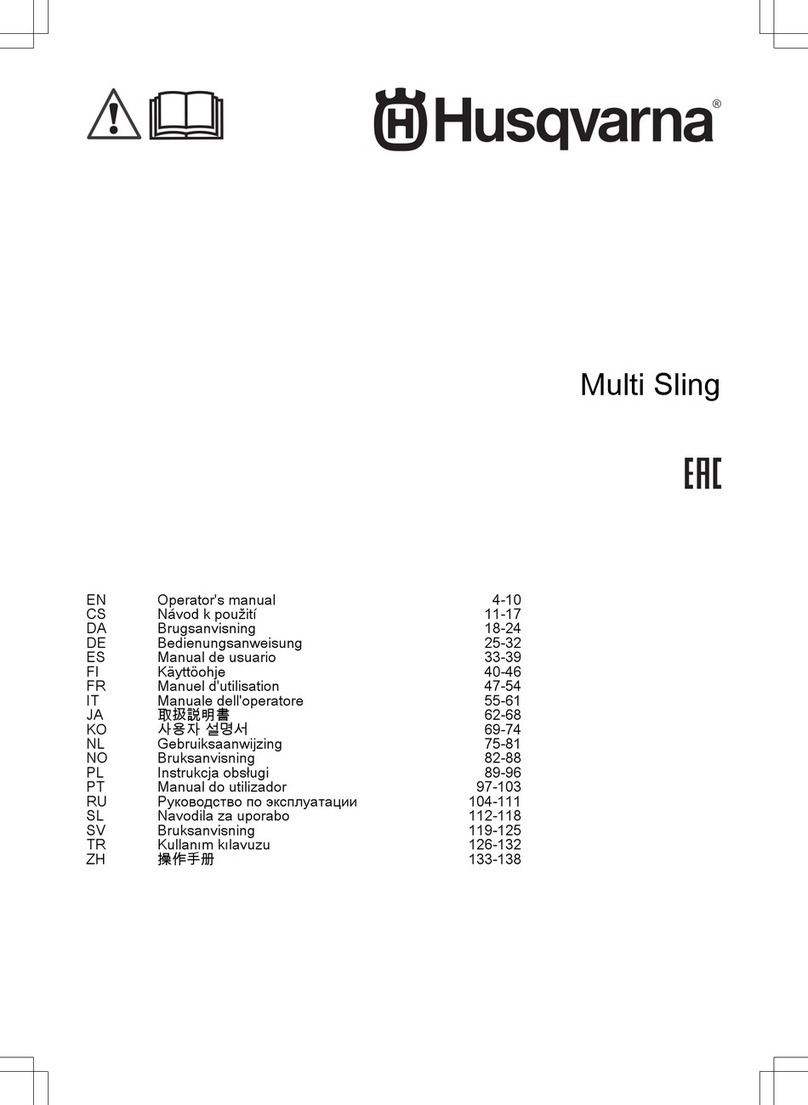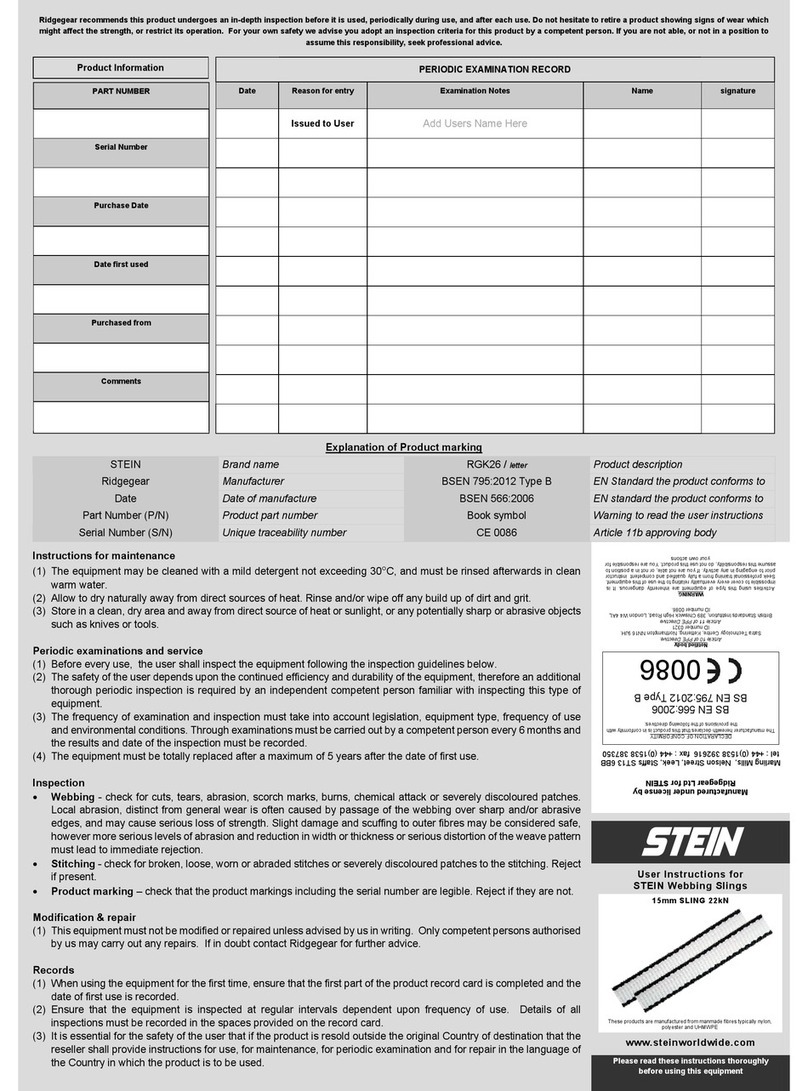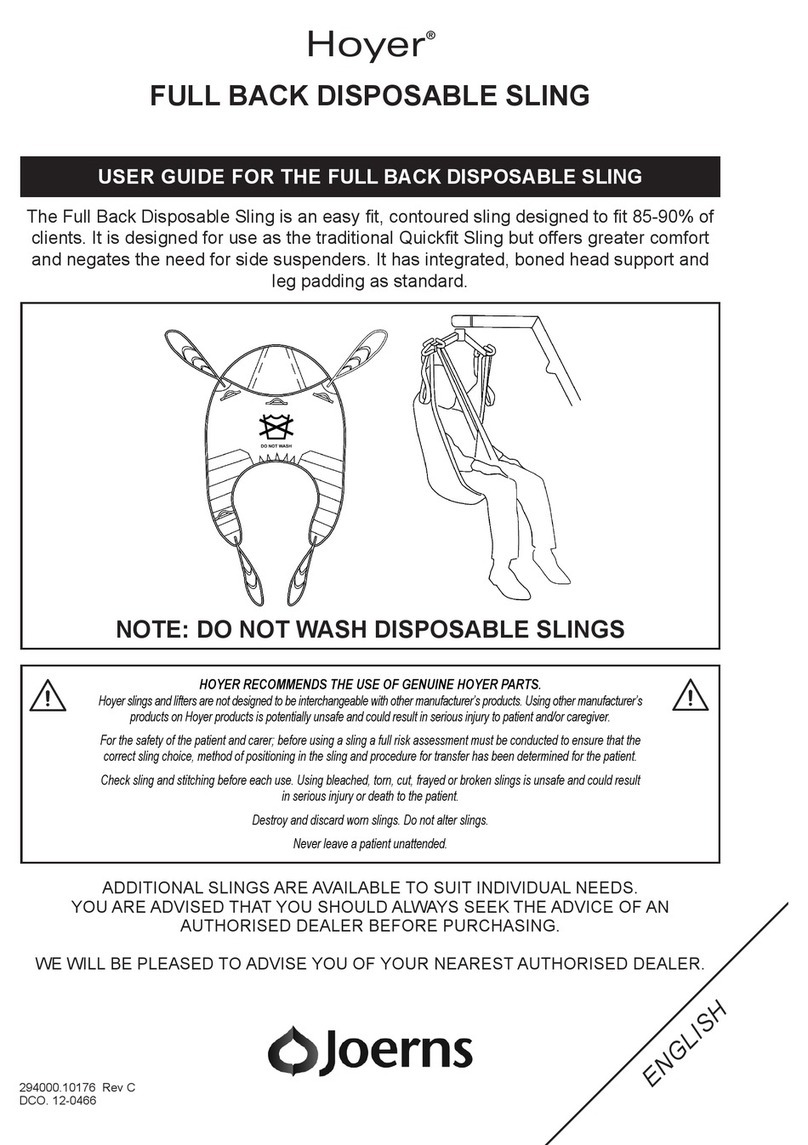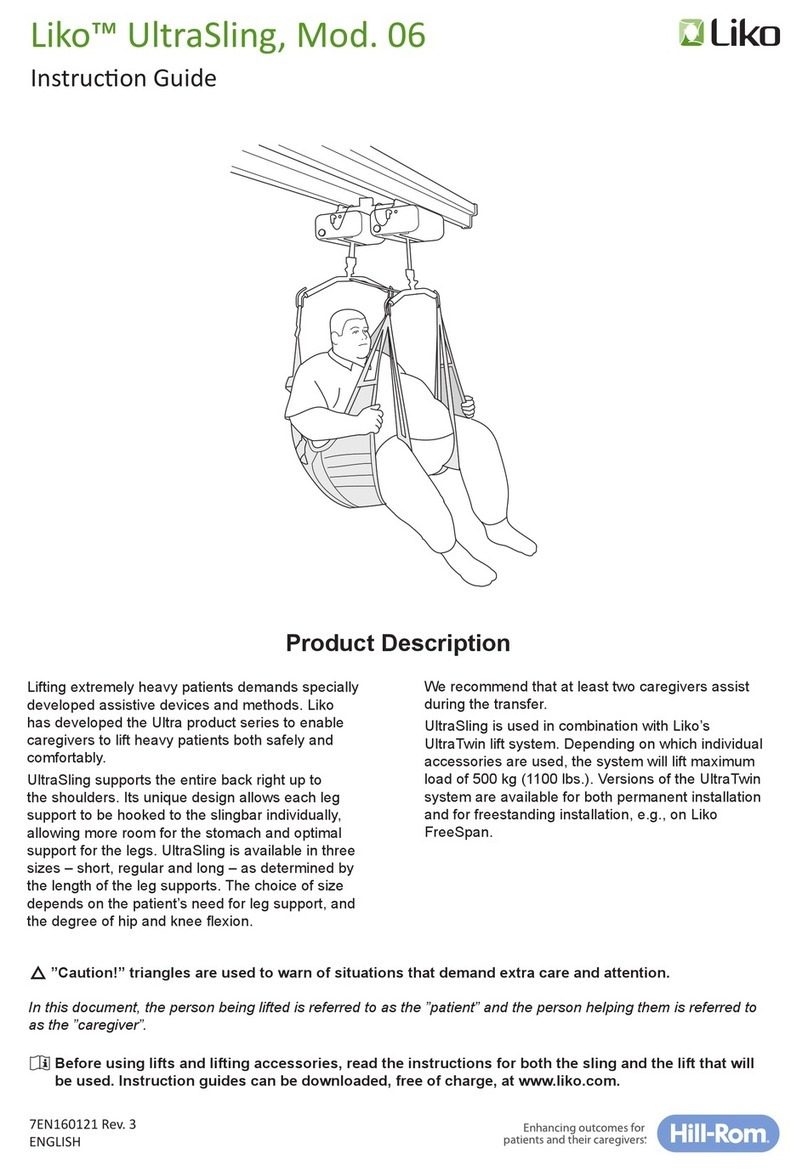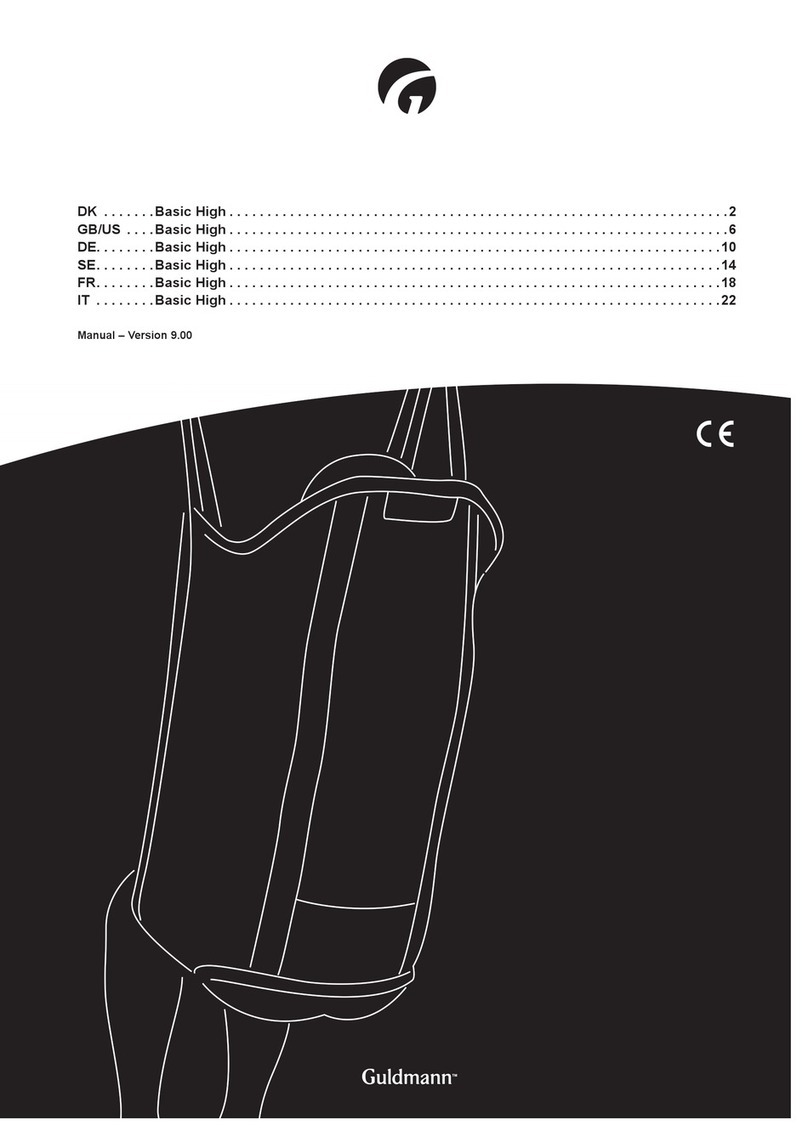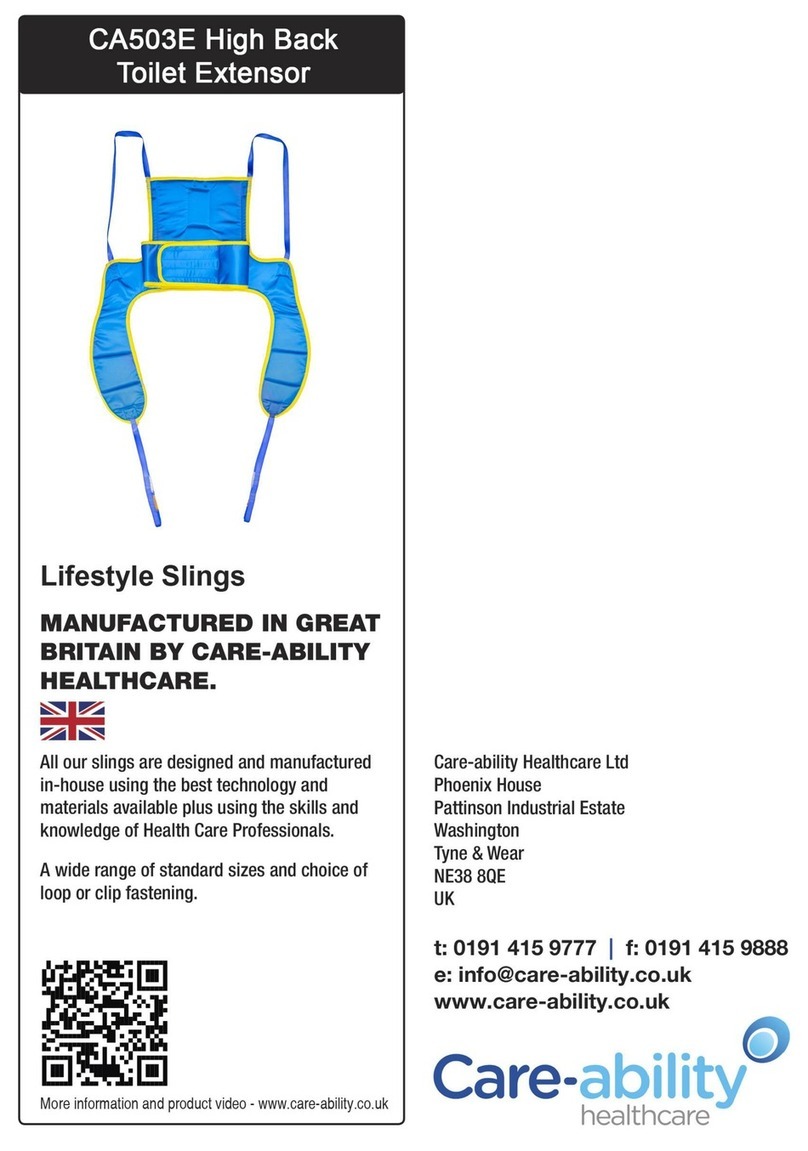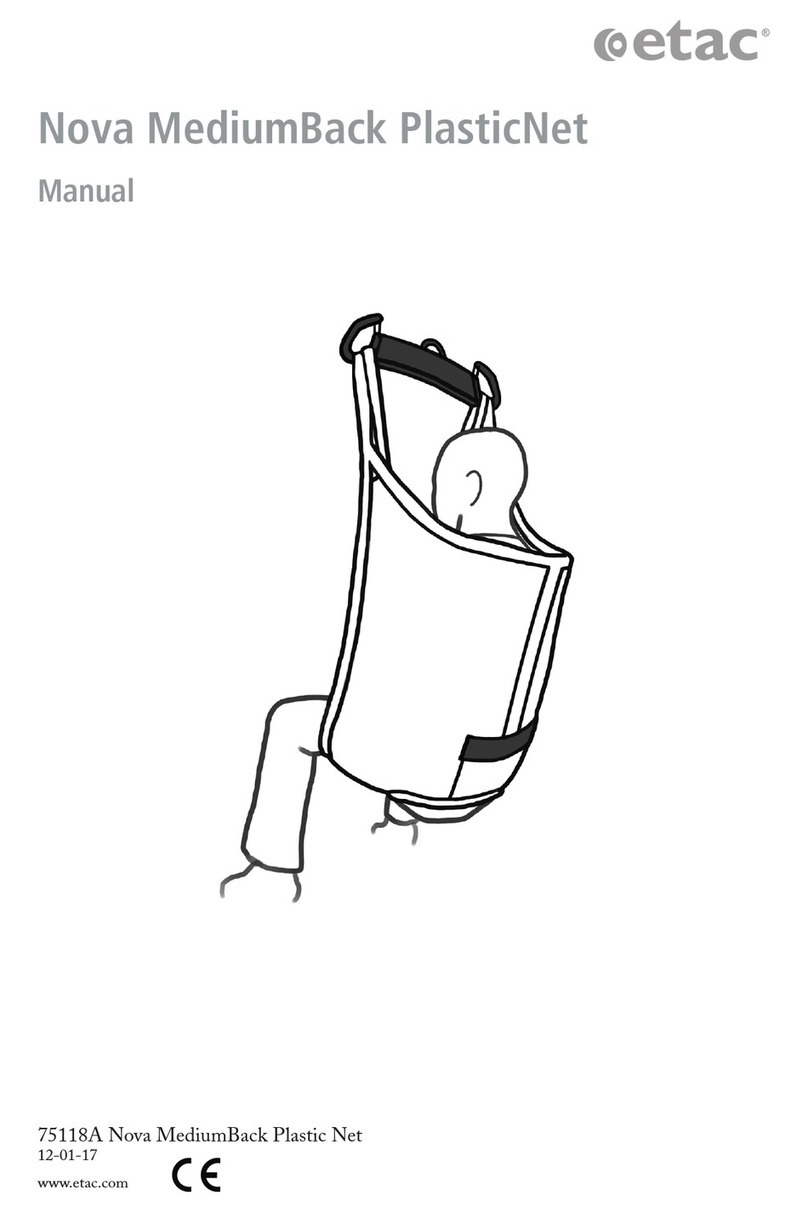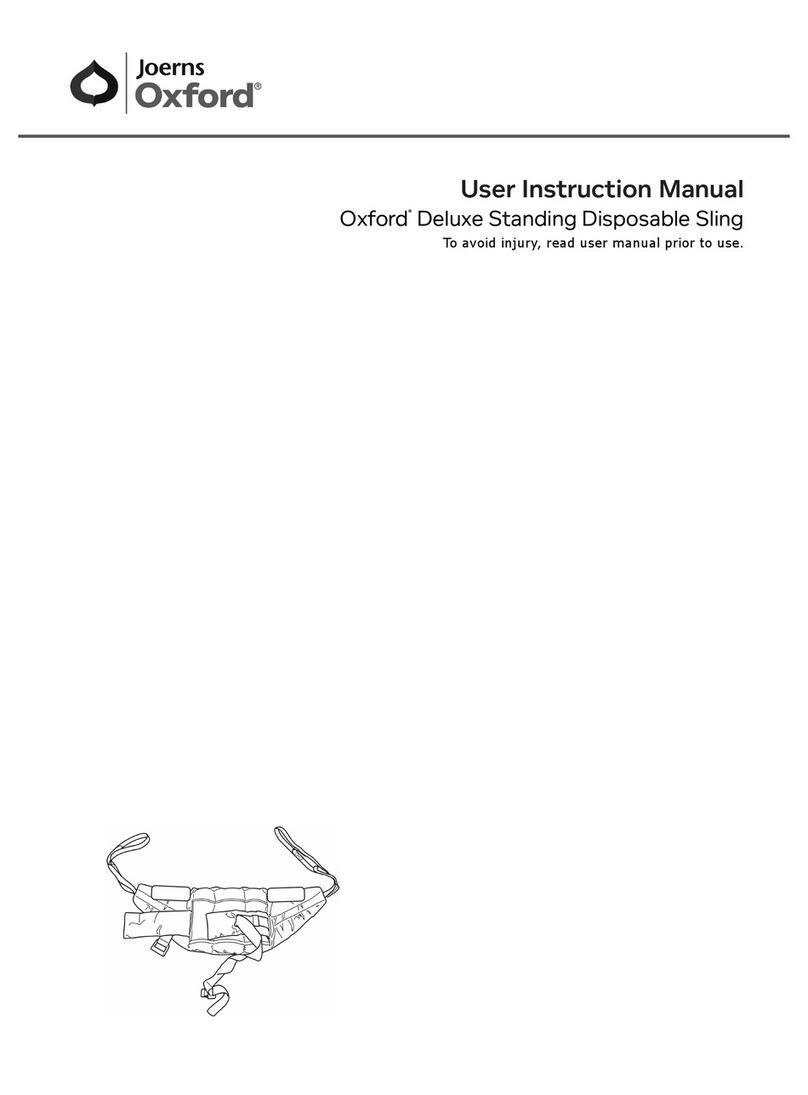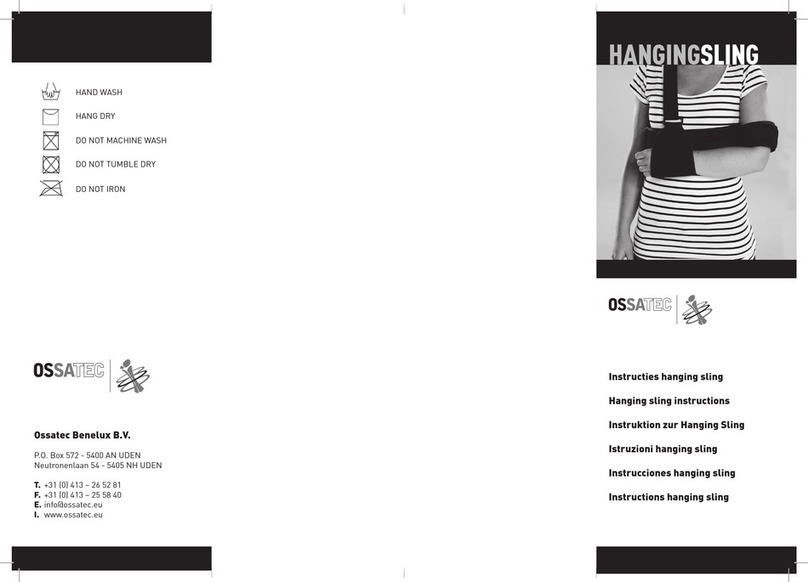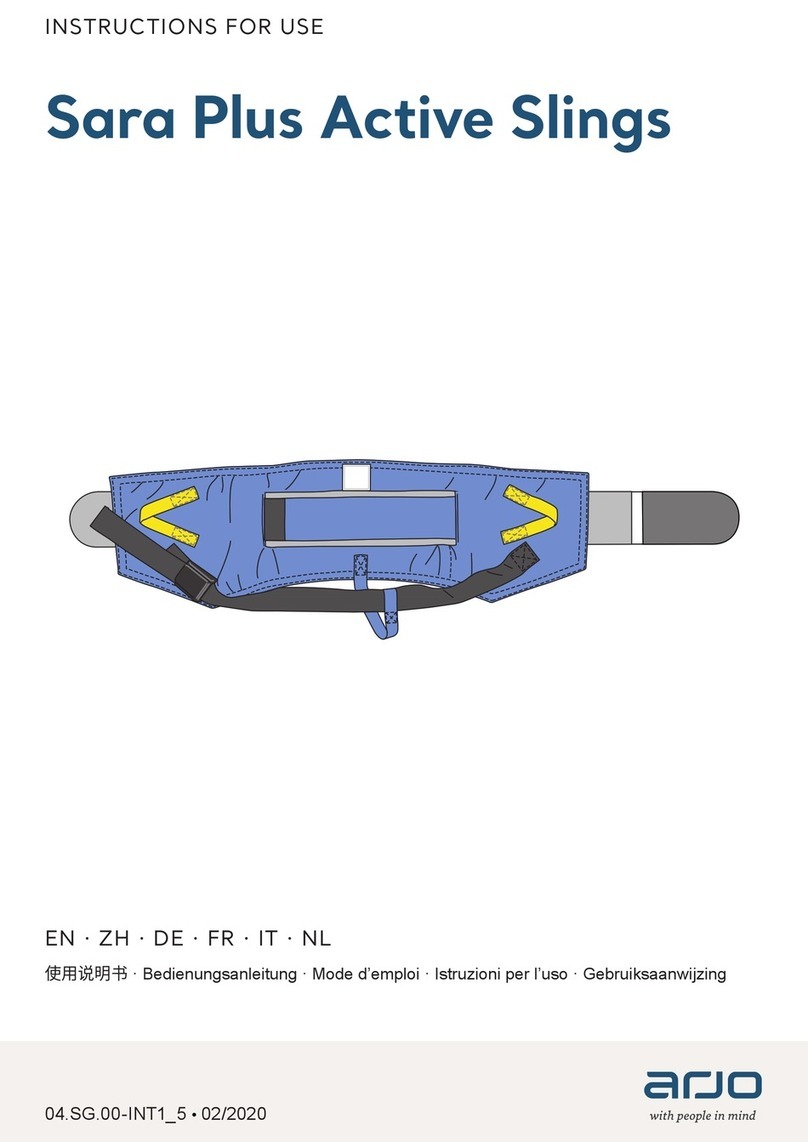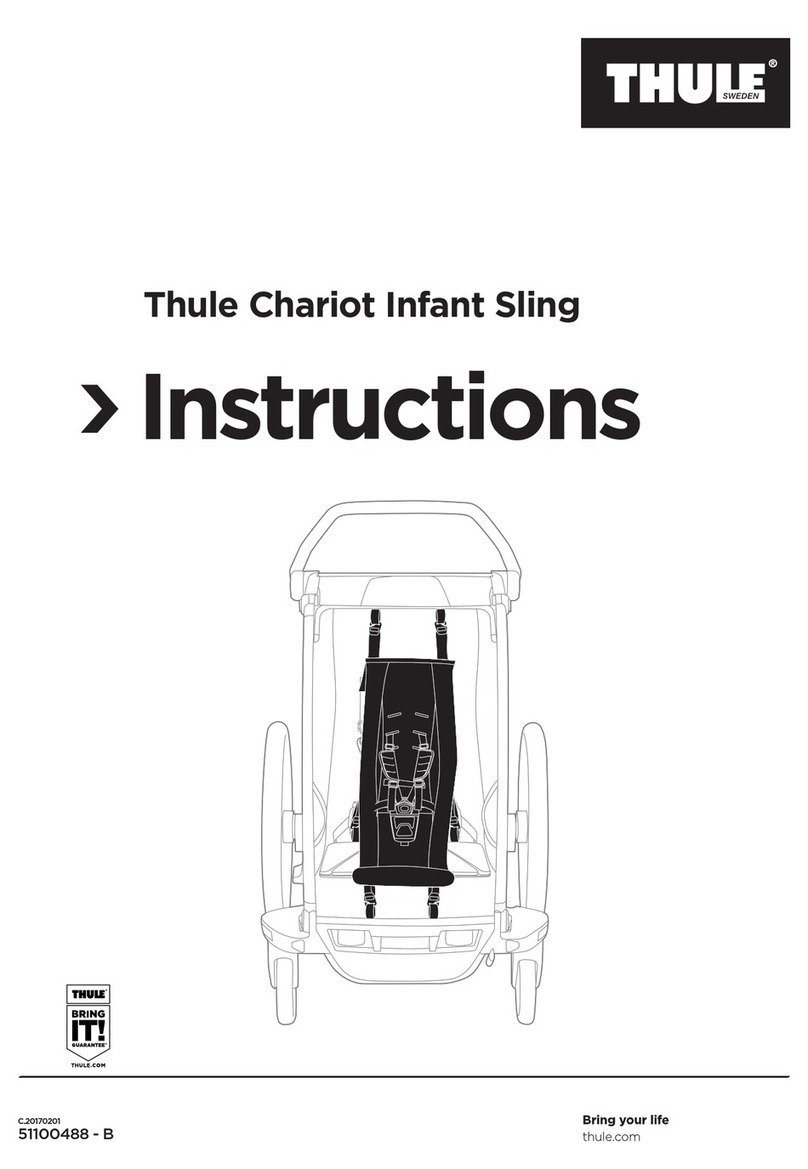Promove Child 1 Sling User manual

The PROMOVE sling
for children and
adolescents
(with or without
head support)
PROM VE
A 2 B WITH
DIGNITY
PROMOVE slings for children and adolescents
Hoisting
Pass the yellow strap through the two yellow handles,
bring the strap back on itself and pass through the ring
(as a larks foot knot). Pull tight. Repeat with the blue
strap through the blue handles and the two white straps
through the two uppermost rear handles.
Place the loops over the hooks on the spreader bar of
the hoist using the most appropriate loop on each strap
depending on the size of the individual and whether the
individual is to be maintained in an upright or reclined
position.
PLEASE NOTE: The hoist straps are not compatible with
hoists using clip attachments, and the operative must
be sure they understand the operation of the hoist and
its suitability for the size and weight of the individual
before usage.
BEWARE: Application of larks foot knot will reduce
the safe working load of the handles.
Benefits to you
All sling models provide a safe and comfortable means
of moving and lifting a disabled individual by two or more
persons. The models are ideal for holidays and days out,
allowing access to many more experiences in places
where you cannot take a hoist.
All Child Sling models have a safe working load (SWL)
of 10stone (140lb / 63kg).
All Adult Standard Slings have a safe working load (SWL)
of 45stone (630lb / 285kg).
Maintenance and replacement
Storage: When not in use keep the sling and accessories
clean and dry in the bag provided. Avoid excessively hot
or humid conditions or direct sunlight.
Lifespan: Under optimal storage conditions and without
use: 10 years. Occasional and appropriate use without
signs of wear and tear and optimal storage and care:
six years. Frequent use: if the sling or any component
appears faded, worn or frayed it should be destroyed
and replaced.
Monitoring: Visually examine the sling and accessories
before each use paying special attention to stitching.
The sling should be examined at least once every six
months by a competent person and recorded, using the
unique serial number on each sling.
Laundering: All components should be washed at 72°C in
a mild detergent and the washing component of the cycle
should be kept at this temperature for at least 10 minutes.
Do not bleach, do not tumble dry. If contaminated by
oil, cleaning materials or unknown substances, the sling
should be destroyed and replaced.
Any malfunction or fault with the Promove sling should
be reported to your Manual Handling Coordinator and
conveyed to the manufacturer.
Promove UK Ltd
T: +44 (0) 1970 820893
facebook.com/promoveproducts
@a2bwithdignity
www.promove.uk.com
PROM VE
A 2 B WITH
DIGNITY
NOT FLAME RESISTANT, KEEP AWAY FROM FIRES
INSTRUCTION OF USE
72

Introduction
The Child 1 Sling is designed for moving a child from 3 – 10
years of age, the Child 2 Sling can be used for children from
8 – 14 years, where a hoist cannot be used.
The Adult Standard Sling is designed for moving and
handling a child from approximately 11 years of age to a
large adult, for transfer where a hoist is not an option.
The sling models require a minimum of two and maximum of
four operatives distributing the weight between them.
A set of four optional hoist straps can be fitted to the
sling for use with a hoist that has a standard spreader bar.
Whenever possible, a hoist should be used.
The sling is intended to be used by those who are fully
trained in manual handling techniques.
PROMOVE slings for children and adolescents
Preparation (T.I.L.E.)
TASK
•Explain to the individual what you propose to do.
Individual
•Assess the capability of the individual; what
assistance, if any, they can give. Identify relevant
health issues.
Load
•Assess the safe working load (SWL).
•Determine if the use of a slide sheet is appropriate.
•Determine how many operatives will be involved
and identify the individual who will take the lead.
•Ensure that each member of the team is aware of
what she/he is required to do.
Environment
•Assess the location, determine what physical
obstructions there are, will certain members of the
team have to step over or around an obstruction,
what is the nature of the floor; slippery, sticky,
uneven, deep carpet.
Deploying the sling
8
2
3
5
5
4
6
7 7
1
2
Repeat the procedure
from the other side taking
the elongated part under
that already in place and
again bring the handle
through to meet the handle
of the same colour.
Both yellow handles
should be held together
and joined with the padded
fabric, securing with Velcro;
in the same way both blue
handles should be held
together and secured
with Velcro.
Turn padded piece
over if necessary to ensure
that both webbing handles
are enclosed within the
padded fabric.
The sling is now in the
correct position for
manually moving the
individual.
Place the sling behind
the person’s back bringing
the person forward if
necessary. The surface with
the label should be away
from the body.
Push the sling down as
far as possible so that the
V-shaped cut is near the
base of the spine.
Bring the two elongated
parts down to either side of
the individual.
Lean the individual
slightly to one side if
appropriate, tuck the sling
partly under the hip.
Then raising each leg
in turn bring one of the
elongated parts beneath
both thighs and pull
through to bring the
coloured handle to meet
the other handle
of the same colour.
3
4
5
6
7
8
Implementing the move
Ensure all operatives have a firm grip. On the guide of the
lead operative, move and slide the individual into the new
location.
Move in short stages, pause, and if necessary, reassess.
Remain aware of the well-being of patient and operatives
at all times.
More moving options
If using two people to implement the move, one person
can stand behind and grasp two handles at the rear (lower
webbing handles on the back oer an alternative lifting
height) with the other person at the front grasping both
sets of coloured handles. Alternatively, one person can
stand either side, each taking one rear handle and one
front handle.
Four people making the lift will reduce the load on each
individual; two should be behind and two at the front.
If possible use in conjunction with a slide sheet to
minimise or eliminate lifting.
Find us on:
facebook.com/promoveproducts
@a2bwithdignity
3
1
5
Other Promove Sling manuals
